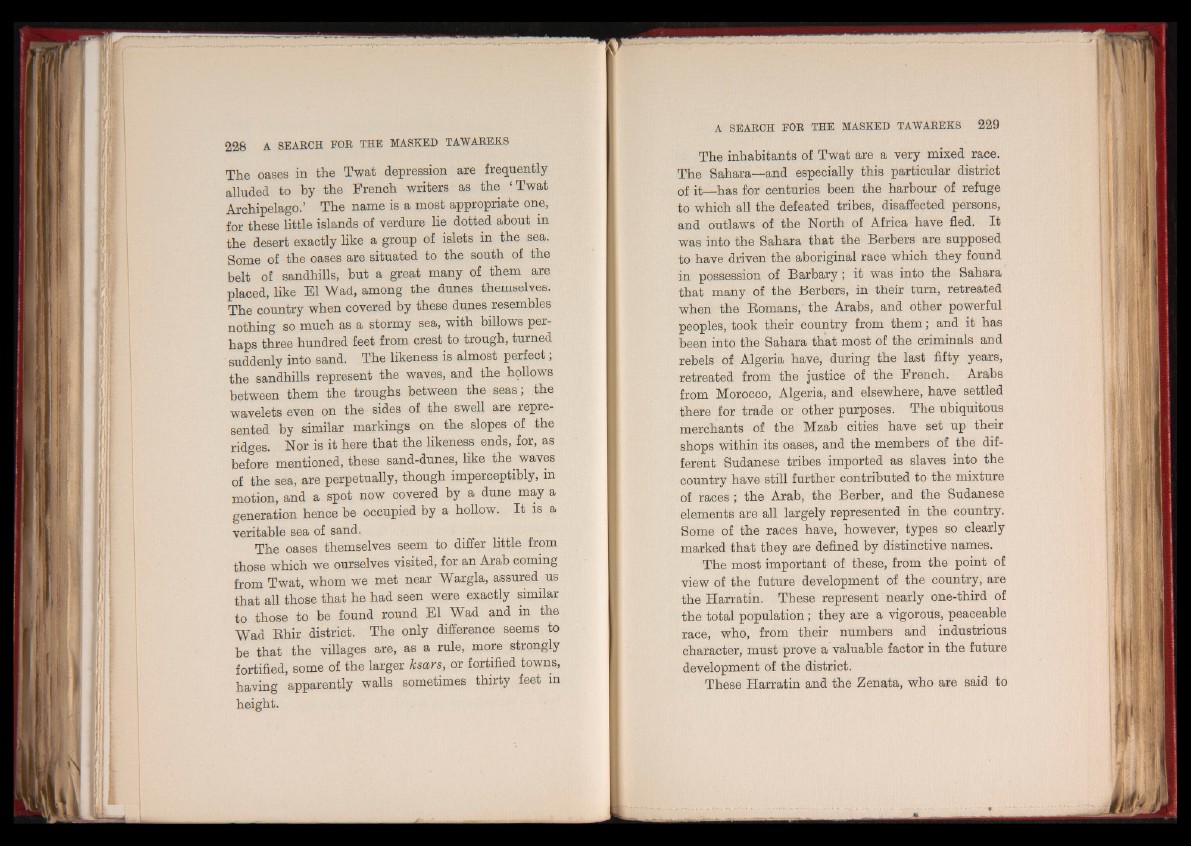
The oases in the Twat depression are frequently
alluded to by the French writers as the ‘Twat
Archipelago.’ The name is a most appropriate one,
for these little islands of verdure lie dotted about in
the desert exactly like a group of islets in the sea.
Some of the oases are situated to the south of the
belt of sandhills, but a great many of them are
placed, like El Wad, among the dunes themselves.
The country when covered by these dunes resembles
nothing so much as a stormy sea, with billows perhaps
three hundred feet from crest to trough, turned
suddenly into sand. The likeness is almost perfect;
the sandhills represent the waves, and the hollows
between them the troughs between the seas; the
wavelets even on the sides of the swell are represented
by similar markings on the slopes of the
ridges. Nor is it here that the likeness ends, for, as
before mentioned, these sand-dunes, like the waves
of the sea, are perpetually, though imperceptibly, in
motion, and a spot now covered by a dune may a
generation hence be occupied by a hollow. It is a
veritable sea of sand.
The oases themselves seem to differ little from
those which we ourselves visited, for an Arab coming
from Twat, whom we met near Wargla, assured us
that all those that he had seen were exactly similar
to those to be found round El Wad and in the
Wad Rhir district. The only difference seems to
be that the villages are, as a rule, more strongly
fortified, some of the larger ksars, or fortified towns,
having apparently walls sometimes thirty feet in
height.
The inhabitants of Twat are a very mixed race.
The Sahara—and especially this particular district
of ft—has for centuries been the harbour of refuge
to which all the defeated tribes, disaffected persons,
and outlaws of the North of Africa have fled. It
was into the Sahara that the Berbers are supposed
to have driven the aboriginal race which they found
in possession of Barbary; it was into the Sahara
that many of the Berbers, in their turn, retreated
when the Romans,' the Arabs, and other powerful
peoples, took their country from them; and it has
been into the Sahara that most of the criminals and
rebels of Algeria have, during the last fifty years,
retreated from the justice of the French. Arabs
from Morocco, Algeria, and elsewhere, have settled
there for trade or other purposes. The ubiquitous
merchants of the Mzab cities have set up their
shops within its oases, and the members of the different
Sudanese tribes imported as slaves into the
country have still further contributed to the mixture
of races; the Arab, the Berber, and the Sudanese
elements are all largely represented in the country.
Some of the races have, however, types so clearly
marked that they are defined by distinctive names.
The most important of these, from the point of
view of the future development of the country, are
the Harratin. These represent nearly one-third of
the total population; they are a vigorous, peaceable
race, who, from their numbers and industrious
character, must prove a valuable factor in the future
development of the district.
These Harratin and the Zenata, who are said to